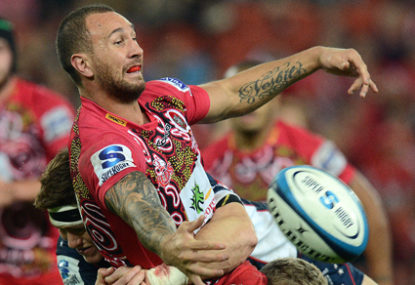Over the weekend, I was asked on Twitter to analyse a play the Highlanders used from a lineout against the Blues.
Unlike most set piece plays, where the strike play is run on the first phase, this play was actually a two-phase play, with the strike play coming on the second phase.
The Highlanders used the first phase to set up the play, with forwards and backs having a role in convincing the Blues they were doing one thing before attempting to do the opposite and striking on the second phase.
Before discussing programmed attack, let me show you what happened with that particular Highlanders play.
Setup
The play starts with a lineout about 35 metres out from the Blues’ line.
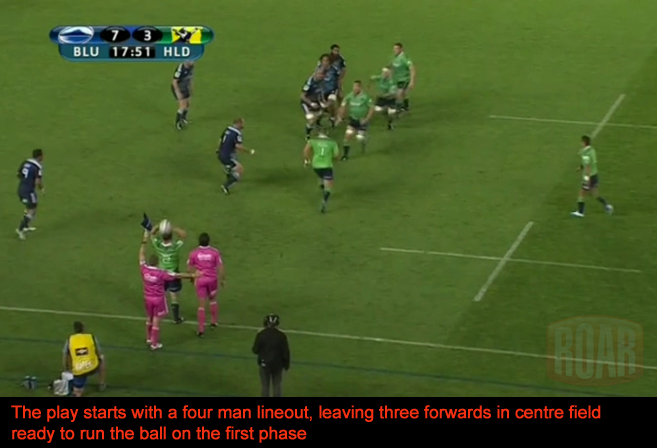
First phase
After winning the lineout, the ball was passed from the 9 to the 12 and then to the pod of three forwards in the centre of the field.
Importantly, the two playmakers stayed on this side of the field together with the forwards from the lineout. This gives the clear impression that the direction of play will be reversed on the second phase in what is commonly known as an ‘11′, where the ball goes one phase one way and then one phase back the other.
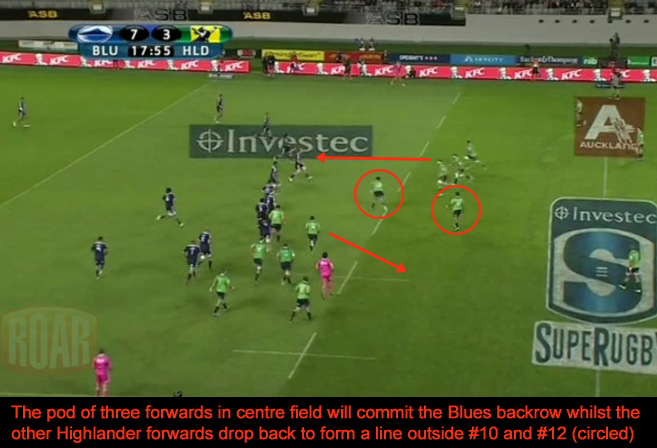
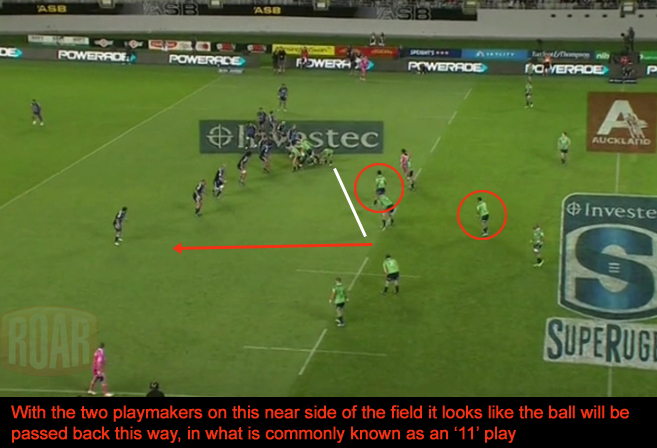
Second phase
The Blues’ defenders immediately start moving back to the near side of the field to cover the line of Highlanders forwards waiting for the ball.
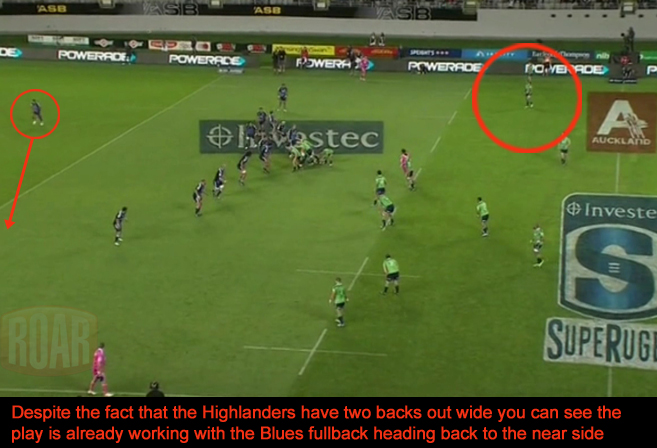
The direction of play is reversed to the number 12.
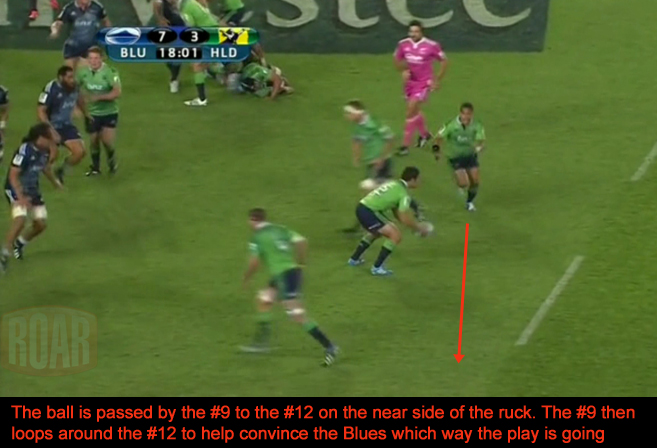
All of the Highlanders have a role to play and with the loop from the number 9, it’s no wonder the Blues are convinced the ball is coming back to the near side of the field.
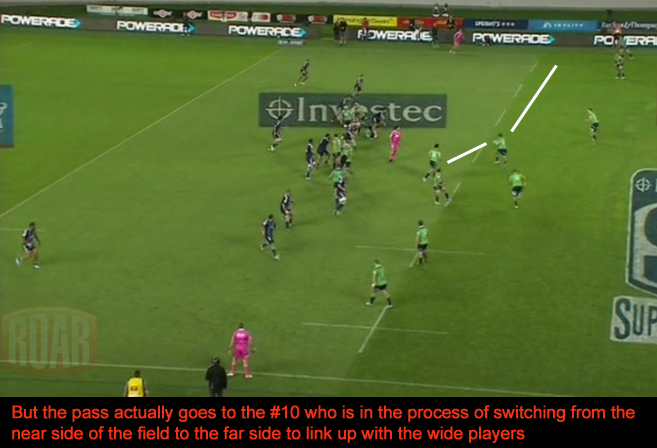
The Blues don’t have any deep cover behind their defensive line on the far side of the field, as the fullback has moved to the near side of the field to cover the ‘11′ play.

Up until this point the play was well executed, but the final pass to the winger went forward and the play was called back.
While the play didn’t result in a try, it was well conceived and achieved the aim of creating space.
Why use programmed attack?
As defences have improved in the modern game, teams have started using more and more multi-phase plays to try and break down the opposition defensive pattern.
In the example I just showed, a strike play could have been tried on the first phase.
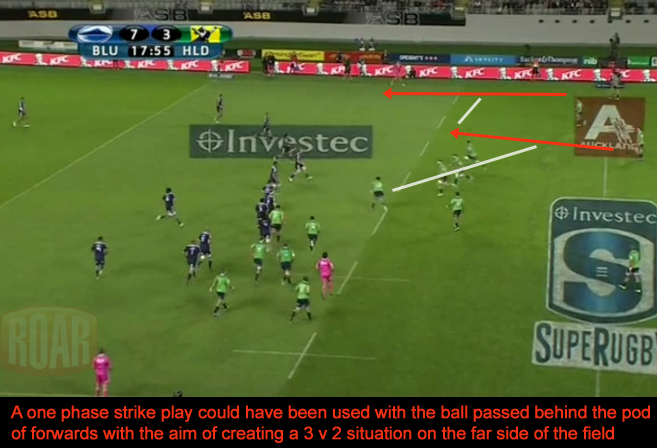
However, the Blues had sufficient numbers to slide across and cover such a play and their fullback was in behind the line, providing additional cover.
Unlike many outside backs in amateur rugby, outside backs in the professional game are usually very capable of making dominant tackles and then turning over the ball at the ensuing ruck, so trying to play wide on the first phase would have involved risks without much prospect of a reward. As a result, many strike plays are designed over two to three phases, with each player’s movement programmed.
We’ve all heard the term ‘play what’s in front of you’ and every team would have the same philosophy, however I doubt there are any professional teams that don’t use programmed attack in early phases from a set piece.
The ‘play what’s in front of you’ mantra usually applies once the first phase or two have been run, when the playmakers can cancel or override the programmed attack if they see another opportunity opening up. I like to say ‘move what’s in front of you first, then play what’s left in front of you’.
Coaches don’t want players to be robots, but a programmed and coordinated attack over multiple phases can often achieve what brilliant individuals can’t.
Programmed attack in general play
Realistically, there is little point in programming plays over more than three phases, because it’s very hard to predict accurately what the defence will do after that. In general play, the programmed attack can last longer than that.
One of the most common examples is a same-way attack where the forwards keep taking the ball the same way across the field until they reach the far touch line.
The idea behind this is to drag as many defenders to one side of the field so there are fewer defenders to contend with once the ball is moved quickly back to the other side of the field.
Similarly, in general play if the attack breaks down, teams often have a default way of attacking while they re-group. Typically this involves forwards in tight, using slow ball through a very narrow pod of players or pick and go.
The aim of these slow ball patterns is not to keep playing with slow ball, because that gives the opposition too long to get their defence organised. So, slow ball patterns usually only last two to three phases while the playmakers get the attack organised again.
While many fans find this type of play frustrating, if the attack isn’t organised, teams usually keep going with their slow ball pattern until it is – there is little point in just flinging the ball wide of the ruck until you’re organised.
The two occasions involving less programmed attack are when there is a turnover or the ball is kicked by the opposition, but even then teams usually have plans for what to do with the ball.
Typically, teams are told that on a turnover they should pass the ball away from where the turnover occurred, as it’s likely there will be less defence away from where the ball was. Most teams have definite plans on how they should attack when the ball is kicked to them.
Teams spend a lot of time training these programmed plays, because they know that with defences being so good these days there is more chance of being successful in attack if most players know where the ball is going.
Of course within any programs, allowances must be made for those gifted individuals like Israel Folau or Quade Cooper, who can make something happen from nothing which their own teammates can’t predict.
Do you think too much attack is programmed in the modern game?
Don’t forget The Roar is hosting a live Q&A with Bill Pulver from 1pm AEDT today. Get your questions in now.





























































































